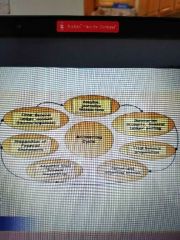![]()
![]()
![]()
Use LEFT and RIGHT arrow keys to navigate between flashcards;
Use UP and DOWN arrow keys to flip the card;
H to show hint;
A reads text to speech;
43 Cards in this Set
- Front
- Back
- 3rd side (hint)
|
Accounting |
Takes data from source documents and turns into meaningful info |
|
|
|
6 Account Categories |
Assets, liabilities, equity, revenue, expenses, drawings |
|
|
|
Assets |
Items a company uses to produce future revenue |
|
|
|
Expense |
Cost incurred to help produce revenue |
|
|
|
Liabilities |
A company's debt |
|
|
|
Drawing |
Money taken out of a business by it's sole owner |
|
|
|
Revenue |
What a company earns when it sells a product or service |
|
|
|
Capital / Equity |
Level of ownership in a business |
|
|
|
After Eating Dinner, Larry Read Comics |
Assets, Expenses, Drawing, liabilities, revenue, capital |
|
|
|
3 things to analyze |
Which accounts, what amounts, whether to credit or debit |
|
|
|
General Journal |
Where journal entries are written |
|
|
|
Ledger |
Where account transactions for an individual account are recorded |
|
|
|
General Ledger |
Book containing all of the account ledgers |
|
|
|
Trial balance |
Proves ONLY the equality of debits and credits, NOT correct analysis, proper recording, omitted entries or whether proper amounts were entered |
|
|
|
Worksheet |
Informal tool used to find any errors quickly |
|
|
|
Items in worksheet |
Trial balance, adjustment to ledger balances, adjusted trial balance, financial statement and account balances |
|
|
|
Adjusting Journal Entries |
Used to account for rev or exp that affect more than one period (July rent paid in June) |
|
|
|
Realization Principle |
Revenue recorded when EARNED |
|
|
|
Matching Principle |
Expenses recorded when INCURRED |
|
|
|
Balance Sheet |
Lists balances of Asset, Liability and Equity/ Capital (A = L + E) |
Too much A.L.E. makes you lose your balance |
|
|
Classified Balance Sheet (Asset Groups) |
Current Assets, Property Plant & Equipment, and Long term assets |
|
|
|
Classified Balance Sheet (Liability groups) |
Current Liabilities, Long term Liabilities |
|
|
|
Income Statement |
Lists period ending balances for revenue and expense categories |
|
|
|
Net Income |
Revenue - Expense |
|
|
|
Single Step Income Statement |
Shows revenue - expenses = net income in summary format |
|
|
|
Multi step Income Statement |
Shows four sections Revenue, costs of goods sold, operating expenses, other expense |
Statement of Profit & Loss, statement of operations |
|
|
Statement of Retained Earnings |
Explains changes in owners investment . Related to income statement. Net Income increases, net loss decreases |
|
|
|
Ending Retained Earnings |
Beginning R.E. + Net Income - Dividend Payments |
|
|
|
Statement of Cash Flows |
Summarized the company's cash receipts and payments over period |
|
|
|
Cash Inflow/Outflow Categories |
Operating, Investing and Financing |
|
|
|
Closing Journal Entries |
Resets Rev and Exp to 0 by transferring to "Income Summary", which is closed into Retained Earnings |
|
|
|
Accounting Cycle |

|
|
|
|
Depreciation |
Recording the cost of long term fixed assets used up or consumed in the production of revenue |
|
|
|
Causes of Depreciation |
Wear and tear; obsolescence |
|
|
|
Depreciable Cost |
Cost of the asset minus salvage value |
|
|
|
Straight Line rate |
1/Life (5 year asset is 1/5 or 20%) |
|
|
|
Units of Production (Activity) rate |
Depreciable Cost / Total units. Depreciable expense is the above rate times units used. |
|
|
|
Double declining balance method |
Double the straight line rate |
|
|
|
Partial Year Depreciation |
Depreciation expense multiplied by (# months used / 12) |
|
|
|
Sum of Years Digits |
SYD = n (n+1)/2 |
|
|
|
Direct Write Off |
Journal directly to AR. Debit Bad Debts Expense, Credit AR |
|
|
|
Balance Sheet Method Bad Debts |
Debit Uncollectable Accounts Expense, Credit Allowance for Doubtful Accounts |
|
|
|
Income Statement Method Bad debts |
Debit Bad Debts Expense, Credit Allowance for Uncollectable Debts |
|

